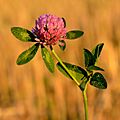Trifolium pratense facts for kids
Quick facts for kids Red Clover |
|
|---|---|
 |
|
| Scientific classification | |
| Domain: | |
| Kingdom: | |
| Division: | |
| Class: | |
| Order: | |
| Family: | |
| Subfamily: | |
| Genus: | |
| Species: |
T. pratense
|
| Binomial name | |
| Trifolium pratense |
|
Red Clover (Trifolium pratense) is a common and important plant. You might have seen its pretty pink or purple flowers growing in fields, meadows, or even along the side of the road! It's a type of plant that belongs to the pea family. Red Clover is originally from Europe, Africa, and Asia, but it has now spread to many other parts of the world, including North America. It's a very useful plant for both animals and the soil.
Contents
What is Red Clover?
Red Clover is a species of plant known for its distinctive reddish-pink flowers. Its scientific name is Trifolium pratense. The word Trifolium means "three-leaved," which describes its leaves that usually grow in groups of three. This plant is a member of the Fabaceae family, also known as the legume or bean family.
Where Does Red Clover Grow?
Red Clover is native to many parts of the world, including Europe, Africa, and Asia. Over time, it has been introduced to new places like North America, Hawaii, and Puerto Rico. This means it was brought there by people and now grows wild.
You can often find Red Clover in many different places:
- In fields where crops are grown
- In pastures where animals graze
- Near roadsides and in open, grassy areas
It prefers to grow in thick, dry soil. It can grow well in many different climates, which is why it has spread so widely around the globe.
What Does Red Clover Look Like?
Red Clover plants typically grow to be about 20 to 80 centimeters (8 to 31 inches) tall.
- Flowers: The flowers are usually a deep pink or reddish-purple color. They grow in dense, round or oval-shaped clusters. These clusters are often about 1.5 to 3 centimeters (0.6 to 1.2 inches) across.
- Leaves: Each leaf is made up of three smaller leaflets, which is why it's called "clover." The leaflets are oval-shaped and often have a pale green or whitish V-shaped mark on them.
- Stems: The stems are usually hairy and can grow upright or spread along the ground.
Red Clover usually blooms from spring to early fall, bringing a splash of color to fields and meadows.
Why is Red Clover Important?
Red Clover is more than just a pretty flower; it's very important for the environment and for farming.
For the Soil
One of the most amazing things about Red Clover is its ability to improve the soil. Like other plants in the pea family, it has a special relationship with tiny living things called bacteria in its roots. These bacteria can take nitrogen from the air and turn it into a form that plants can use. This process is called "nitrogen fixation."
- It makes the soil more fertile naturally.
- It reduces the need for chemical fertilizers.
- It helps other plants grow better when planted nearby or after clover.
Farmers often plant Red Clover as a "cover crop" to protect and enrich their soil.
For Animals
Red Clover is a very important food source for many animals:
- Livestock: It's a popular plant for feeding farm animals like cows, sheep, and horses. It's full of nutrients and helps them grow strong.
- Pollinators: The flowers are a favorite of bees, especially bumblebees, which collect nectar and pollen. By visiting the flowers, bees help the plant make seeds, which is important for the plant's reproduction.
- Wildlife: Many other insects and small animals also rely on Red Clover for food and shelter.
For People
Historically, Red Clover has been used in traditional medicine for various purposes. Today, it's sometimes used in herbal supplements. It's also a beautiful plant that adds to the natural beauty of our landscapes.
How Red Clover Grows (Life Cycle)
Red Clover can grow as an annual (living for one year), a biennial (living for two years), or a short-lived perennial (living for a few years). It spreads by seeds.
- Seeds: The plant produces small seeds after its flowers are pollinated.
- Germination: These seeds fall to the ground and can sprout into new plants when conditions are right (enough warmth and moisture).
- Growth: The new plants grow roots, stems, and leaves, eventually producing their own flowers and seeds, continuing the cycle.
Its ability to fix nitrogen and grow quickly makes it a valuable plant in many ecosystems.
Images for kids
See also
 In Spanish: Trébol rojo para niños
In Spanish: Trébol rojo para niños




